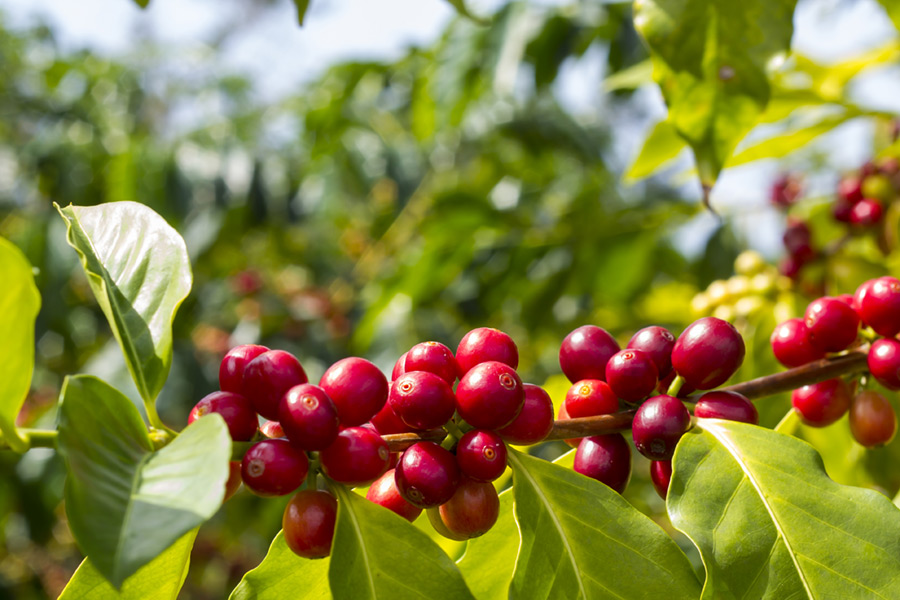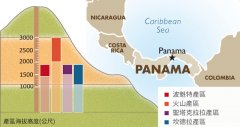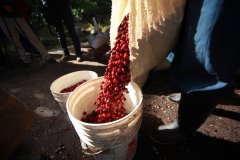World Map of Coffee-- the unique microclimate of Panamanian Coffee makes the legendary Coffee Road

For professional baristas, please follow the coffee workshop (Wechat official account cafe_style)
The introductory coffee book Coffee basics-a quick and easy guide (Kevin Knox, John Wiley & Sons Publishings), published in 1997, describes Panamanian coffee as follows: "it is at best similar to coffee from the Tres Rios region of Costa Rica: balanced, light, and only suitable for a refreshing morning." If the author republishes the book today, these few numbers will certainly be rewritten. Over the past 16 years, Panama has changed from a country that grows coffee for domestic sales to a legend in the international industry.
Panama is located at the southern tip of Central America, bordering Colombia. If you ask your peers about their impression of this country, they will probably answer "Canal". The isthmus (isthmus), located in the North and South American continent, has been of great strategic value since the 16th century (Columbus era). In the early 19th century, Panama was politically more southward, and at one point formed the Greater Republic of Colombia (Gran Colombia) with Colombia, Vaguadore and Venezuela. But since 1903, it has seceded from the alliance with the help of the United States, and its national fortune was destined to be linked to the United States at the moment the canal was built. The Panama Canal, which runs through Central America and connects the Pacific Ocean, the Caribbean and the Atlantic Ocean, has not only opened up shipping trade, but also brought a great deal of agricultural knowledge from the United States and Europe; many retirees in North America chose to settle in Panama with a mild climate and a low cost of living index, which indirectly contributed to the stories of boutique coffee legends and emerald estates.
North Wind increases Coffee fructose content
Compared with the commercial towns built around canals in the east, the western mountains bordering Costa Rica are dominated by farming. The Chiriqui province has a good infrastructure, so coffee has been grown in areas such as Bouquete and Volcan since it was introduced from Costa Rica in 1820. Although the production capacity is only 1/10 of that of the former (2007), its unique microclimate (micro-climate) is particularly suitable for the growth of boutique coffee: the country's Rain Water, sometimes from the Pacific, sometimes from the Atlantic. At the end of the rainy season, a northerly wind that locals call "Bajareque" blows through the mountains like air-conditioning, slowing down the ripening rate of coffee fruit and raising sugar content. Farmers usually hire indigenous Nobes to take charge of the harvest. With the help of the United States, the world's largest consumer of coffee, Panama's processing technology is among the best in Latin America.
"Geisha" Yang Wei
Gesha is almost synonymous with modern Panamanian coffee. Before the Feicui Special selection (Esmeralda Special) became famous in 2003, the common beans in the country were Typica, Caturra, San Ramon (Brazilian Typica variety) and Mundo Novo. The Panamanian Fine Coffee Association (SCAP) was founded in 1997, and the National Competition (Best of Panama,BOP) held in the same year was two years earlier than the first COE! This year's BOP is divided into three groups: "traditional Coffee: washing or Honey treatment", "Solar-Geisha and non-Geisha" and "Water washing Geisha". Geisha coffee stands out from the crowd and has been at the forefront of the competition for many years since 2003. In addition, the division of the treatment method is becoming more and more obvious, which shows that similar grouping methods will be adopted in competitions in other countries in the future.
Patrick Tam / tr. by Phil Newell)
Important Notice :
前街咖啡 FrontStreet Coffee has moved to new addredd:
FrontStreet Coffee Address: 315,Donghua East Road,GuangZhou
Tel:020 38364473
- Prev

Introduction to the four Coffee producing areas in Panama and the Road to Fine Coffee the most Rose Summer in the World-Panama
Communication of professional baristas Please follow the History of Coffee in Panama in the Coffee Workshop (official Wechat account cafe_style) in 1780, the history of Panamanian coffee began when Europeans first introduced the first Typica tree species to Panama. For Panamanians at that time, such drinks were both novel and mysterious, and not only conquered people quickly.
- Next

Is Panamanian coffee expensive? [the most expensive Coffee in the World] Rose Summer Coffee beans from Jade Manor in Panama
For the exchange of professional baristas, please follow the coffee workshop (Wechat official account cafe_style) the Panamanian Fine Coffee Association held the best Panamanian coffee auction (Best of Panama eAuction) in July this year. A coffee bean was successfully auctioned at a high price of US $601 per pound, breaking the previous record, so fast, this Bana called Panama Geisha
Related
- Detailed explanation of Jadeite planting Land in Panamanian Jadeite Manor introduction to the grading system of Jadeite competitive bidding, Red bid, Green bid and Rose Summer
- Story of Coffee planting in Brenka region of Costa Rica Stonehenge Manor anaerobic heavy honey treatment of flavor mouth
- What's on the barrel of Blue Mountain Coffee beans?
- Can American coffee also pull flowers? How to use hot American style to pull out a good-looking pattern?
- Can you make a cold extract with coffee beans? What is the right proportion for cold-extracted coffee formula?
- Indonesian PWN Gold Mandrine Coffee Origin Features Flavor How to Chong? Mandolin coffee is American.
- A brief introduction to the flavor characteristics of Brazilian yellow bourbon coffee beans
- What is the effect of different water quality on the flavor of cold-extracted coffee? What kind of water is best for brewing coffee?
- Why do you think of Rose Summer whenever you mention Panamanian coffee?
- Introduction to the characteristics of authentic blue mountain coffee bean producing areas? What is the CIB Coffee Authority in Jamaica?

